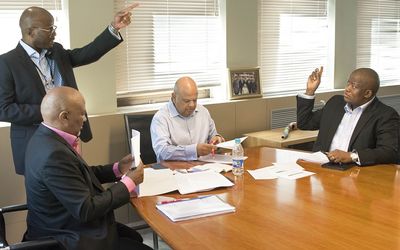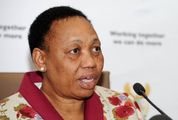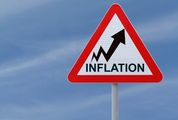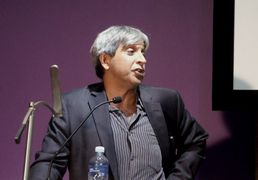THE first thing journalists noticed when Finance Minister Pravin Gordhan and his team sat down on Tuesday morning to address the pre-budget media briefing was the absence of South African Revenue Service (Sars) commissioner Tom Moyane. Gordhan dodged the question delicately when asked to explain the commissioner’s absence, and pointedly expressed his confidence in Sars’ 14,000 employees, rather than their boss.
But if anyone had forgotten just how tense a year it has been since the last budget, the Moyane moment was one reminder. The thank you Gordhan extended to the journalists who had come along to welcome "the new old guy" was another.
The new-old theme was at the core of a budget that was new in that, following his reappointment amid December’s turmoil, Gordhan seems to have the political backing to take tougher action to rein in public spending and float notions such as selling a stake in SA Airways, that he did not have in his previous term.
Yet, it was old in that there was a surprising degree of continuity with the budgets of the past three or four years, since Gordhan began on the path of fiscal consolidation. And although Wednesday’s budget was significantly tougher and may well serve to buy time with rating agencies and investors, it also took a punt that the economy will improve in a year or two.
After the damage December’s finance minister debacle did to confidence in SA’s fiscal policy makers, Gordhan needed not just to meet the fiscal consolidation targets his predecessor, Nhlanha Nene, set out in October’s medium-term budget, but to beat them. To rebuild credibility, he needed to get the deficit lower and stabilise the ever-rising public debt burden faster, despite an even worse economic outlook.
On the face of it, he managed to do just that. The consolidated deficit for the fiscal year just ending, 2015-16, will come in line with last February’s estimate at 3.9%, and even though the economic slide meant revenue was almost R12bn short, this was lower than most economists expected.
Gordhan managed to rebalance the numbers to give a projected deficit of 3.2% for the coming year, slightly lower than October’s estimate, although higher than February’s, and to get the next two years’ deficits down to average 2.6%. That enables him to bring forward by a year the point at which the government debt ratio stabilises, at 46.2% of gross domestic product (GDP) in 2017-18, even though gross debt will now go over the 50% level.
In the first of the three years he does this, mainly on the revenue side, adding R18.1bn to tax collections. There was no value-added tax (VAT) increase, but more than a third of the extra tax will come from much higher fuel and sin taxes, which are less controversial than VAT, but in their way, just as regressive, affecting the poor more than the rich. But with much rhetoric about equity and fairness, the minister also bumped up taxes such as capital gains tax and estate duty that affect mainly wealthy folk, à la Piketty’s "wealth tax", we were told.
The consolidation path then relies on adding a further R15bn of revenue in each of the following two years, from tax changes the Treasury declines to specify or even speculate on for now.
That surely would have to include increases of at least one percentage point in the VAT rate, more if government wants to go ahead with initiatives such as a National Health Insurance, or expanding access to higher education. But there clearly is a hope the economic growth rate will pick up more than expected in the next couple of years, or that tax collections will somehow turn out to be more buoyant than forecast.
A Treasury official noted that while the growth forecast might be a little optimistic, budgeting has been very conservative on the revenue side, using a "buoyancy" rate of just 1.1% — that is, how much faster revenue grows than GDP — that is lower than the average in recent years.
On the expenditure side too, Gordhan kicked the can down the road to some extent, out to the provinces. It was an austerity budget as such, with cuts to the expenditure ceiling rather than to expenditure itself. But that means departments and provinces will have to find efficiencies and make savings including reallocating spending to accommodate new money for university funding, drought relief and so on.
The coming year will see real spending growth of just 0.3%, but the real cuts in spending, particularly in personnel costs, come in the later years, with the expenditure ceiling cut by R10bn in 2017-18 and R15bn in 2018-19. The government payroll system, Persal, has been "locked", so there can be no new hires unless these are justified with revised human resources plans. Treasury officials see about 20,000 jobs being affected during the next three years, with the 1.3-million strong public service falling to 1.275-million.
The last time the government did this was in the late 1990s; the resistance to it could be much greater now given the strength and political clout of the public sector unions. And, although the plan is that managerial and administrative staff rather than teachers and nurses will be affected, the chance that the best people are lost, and that budgets will be cut in ways that are far from optimal, particularly in poorer and less well-managed provinces, is substantial.
That Gordhan has got his colleagues to agree to trying it at all is significant. Clearly, he has more support than in his previous incarnation as finance minister to tackle issues such as the public sector payroll and privatisation (although he emphasised he hadn’t used the "P" word, but talked rather about co-investment with the private sector and equity stakes).
He is working with business too on initiatives to try to boost growth. Business’s pleas for the government to cut red tape and offer policy certainty have been heard. Whether they will be acted on is another matter. And whether there is the political will to tackle constraints and make growth and investment a priority in reality, rather than in rhetoric, is still an open question.
In the short term, the more disciplined numbers Gordhan tabled on Wednesday might be enough to fend off a downgrade by the ratings agencies. But even if they are, the threat of junk status is still very much there. The global environment is unfriendly and SA’s own goals inhibit its growth even more.
Gordhan’s fiscal framework relies on growth forecasts, particularly in the outer two years, that are more optimistic than many in the market. It relies, too, on the political leadership being willing and able to implement the cuts that have been pencilled in, and on Gordhan having the political cover to deliver on the budget promises.
That makes the Moyane situation a particularly intriguing one to watch as one index of whether Gordhan has the clout the market hopes he does, given the clashes between minister and commissioner.
"Give me a couple of weeks and I will get back to you," the minister promised journalists on Tuesday when they asked about Moyane. It could be a tense wait.

FINISHING TOUCHES: Deputy Finance Minister Mcebisi Jonas, sitting, left, Finance Minister Pravin Gordhan, centre, and Treasury director-general Lungisa Fuzile work on the budget presentation on Tuesday afternoon. Standing on the left is Dondo Mogajane, chief operating officer at the Treasury. Picture: TREVOR SAMSON
THE first thing journalists noticed when Finance Minister Pravin Gordhan and his team sat down on Tuesday morning to address the pre-budget media briefing was the absence of South African Revenue Service (Sars) commissioner Tom Moyane. Gordhan dodged the question delicately when asked to explain the commissioner’s absence, and pointedly expressed his confidence in Sars’ 14,000 employees, rather than their boss.
But if anyone had forgotten just how tense a year it has been since the last budget, the Moyane moment was one reminder. The thank you Gordhan extended to the journalists who had come along to welcome "the new old guy" was another.
The new-old theme was at the core of a budget that was new in that, following his reappointment amid December’s turmoil, Gordhan seems to have the political backing to take tougher action to rein in public spending and float notions such as selling a stake in SA Airways, that he did not have in his previous term.
Yet, it was old in that there was a surprising degree of continuity with the budgets of the past three or four years, since Gordhan began on the path of fiscal consolidation. And although Wednesday’s budget was significantly tougher and may well serve to buy time with rating agencies and investors, it also took a punt that the economy will improve in a year or two.
After the damage December’s finance minister debacle did to confidence in SA’s fiscal policy makers, Gordhan needed not just to meet the fiscal consolidation targets his predecessor, Nhlanha Nene, set out in October’s medium-term budget, but to beat them. To rebuild credibility, he needed to get the deficit lower and stabilise the ever-rising public debt burden faster, despite an even worse economic outlook.
On the face of it, he managed to do just that. The consolidated deficit for the fiscal year just ending, 2015-16, will come in line with last February’s estimate at 3.9%, and even though the economic slide meant revenue was almost R12bn short, this was lower than most economists expected.
Gordhan managed to rebalance the numbers to give a projected deficit of 3.2% for the coming year, slightly lower than October’s estimate, although higher than February’s, and to get the next two years’ deficits down to average 2.6%. That enables him to bring forward by a year the point at which the government debt ratio stabilises, at 46.2% of gross domestic product (GDP) in 2017-18, even though gross debt will now go over the 50% level.
In the first of the three years he does this, mainly on the revenue side, adding R18.1bn to tax collections. There was no value-added tax (VAT) increase, but more than a third of the extra tax will come from much higher fuel and sin taxes, which are less controversial than VAT, but in their way, just as regressive, affecting the poor more than the rich. But with much rhetoric about equity and fairness, the minister also bumped up taxes such as capital gains tax and estate duty that affect mainly wealthy folk, à la Piketty’s "wealth tax", we were told.
The consolidation path then relies on adding a further R15bn of revenue in each of the following two years, from tax changes the Treasury declines to specify or even speculate on for now.
That surely would have to include increases of at least one percentage point in the VAT rate, more if government wants to go ahead with initiatives such as a National Health Insurance, or expanding access to higher education. But there clearly is a hope the economic growth rate will pick up more than expected in the next couple of years, or that tax collections will somehow turn out to be more buoyant than forecast.
A Treasury official noted that while the growth forecast might be a little optimistic, budgeting has been very conservative on the revenue side, using a "buoyancy" rate of just 1.1% — that is, how much faster revenue grows than GDP — that is lower than the average in recent years.
On the expenditure side too, Gordhan kicked the can down the road to some extent, out to the provinces. It was an austerity budget as such, with cuts to the expenditure ceiling rather than to expenditure itself. But that means departments and provinces will have to find efficiencies and make savings including reallocating spending to accommodate new money for university funding, drought relief and so on.
The coming year will see real spending growth of just 0.3%, but the real cuts in spending, particularly in personnel costs, come in the later years, with the expenditure ceiling cut by R10bn in 2017-18 and R15bn in 2018-19. The government payroll system, Persal, has been "locked", so there can be no new hires unless these are justified with revised human resources plans. Treasury officials see about 20,000 jobs being affected during the next three years, with the 1.3-million strong public service falling to 1.275-million.
The last time the government did this was in the late 1990s; the resistance to it could be much greater now given the strength and political clout of the public sector unions. And, although the plan is that managerial and administrative staff rather than teachers and nurses will be affected, the chance that the best people are lost, and that budgets will be cut in ways that are far from optimal, particularly in poorer and less well-managed provinces, is substantial.
That Gordhan has got his colleagues to agree to trying it at all is significant. Clearly, he has more support than in his previous incarnation as finance minister to tackle issues such as the public sector payroll and privatisation (although he emphasised he hadn’t used the "P" word, but talked rather about co-investment with the private sector and equity stakes).
He is working with business too on initiatives to try to boost growth. Business’s pleas for the government to cut red tape and offer policy certainty have been heard. Whether they will be acted on is another matter. And whether there is the political will to tackle constraints and make growth and investment a priority in reality, rather than in rhetoric, is still an open question.
In the short term, the more disciplined numbers Gordhan tabled on Wednesday might be enough to fend off a downgrade by the ratings agencies. But even if they are, the threat of junk status is still very much there. The global environment is unfriendly and SA’s own goals inhibit its growth even more.
Gordhan’s fiscal framework relies on growth forecasts, particularly in the outer two years, that are more optimistic than many in the market. It relies, too, on the political leadership being willing and able to implement the cuts that have been pencilled in, and on Gordhan having the political cover to deliver on the budget promises.
That makes the Moyane situation a particularly intriguing one to watch as one index of whether Gordhan has the clout the market hopes he does, given the clashes between minister and commissioner.
"Give me a couple of weeks and I will get back to you," the minister promised journalists on Tuesday when they asked about Moyane. It could be a tense wait.














 News, views and analysis of Finance Minister Pravin Gordhan's 2016 budget
News, views and analysis of Finance Minister Pravin Gordhan's 2016 budget










Change: -0.47%
Change: -0.57%
Change: -1.76%
Change: -0.34%
Change: 0.02%
Data supplied by Profile Data
Change: -1.49%
Change: 0.08%
Change: -0.47%
Change: 0.00%
Change: -0.04%
Data supplied by Profile Data
Change: -0.34%
Change: 0.03%
Change: -0.10%
Change: -0.22%
Change: -0.81%
Data supplied by Profile Data
Change: -0.28%
Change: -1.15%
Change: -0.07%
Change: -1.21%
Change: -0.22%
Data supplied by Profile Data